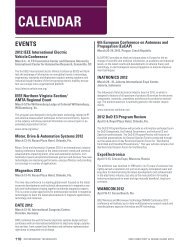2011 EMC Directory & Design Guide - Interference Technology
2011 EMC Directory & Design Guide - Interference Technology
2011 EMC Directory & Design Guide - Interference Technology
Create successful ePaper yourself
Turn your PDF publications into a flip-book with our unique Google optimized e-Paper software.
B o r g s t r o m<br />
testing & test equipment<br />
SECTION 19: INDUCED SIGNAL SUSCEPTIBILITY<br />
The tests in this section are performed to determine that<br />
the EUT can operate as required when the equipment and<br />
interconnecting cables are subjected to audio frequency<br />
electric fields, magnetic fields and transient voltage spikes.<br />
The test levels for the interconnecting cable tests are determined<br />
by the length of wire that is exposed to the radiating<br />
wire. For the Inductive Switching Transients (induced spikes)<br />
test, the exposed length is either 1.2 or 3.0 meters, with the<br />
amplitude of the spikes applied to the radiating wire being<br />
at least 600 Volts peak-to-peak.<br />
For the magnetic and electric fields induced into cables,<br />
the test level is defined as the product of the length of interconnecting<br />
cable that is exposed to the radiating wire and<br />
the rms voltage or current applied to the wire. This test level<br />
is given as "volts x meters" (V-m), or "amps x meters" (A-m).<br />
For example, category Z requires an electric field test level of<br />
1800 V-m, which is typically obtained by exposing 3 meters<br />
of cable to a radiating wire with 600 volts rms applied to<br />
it. If less than 3 meters of cable is exposed to the radiating<br />
wire (due to space restrictions, for example), the voltage applied<br />
to the wire must be increased so that the test level of<br />
1800 V-m is achieved. The exception to this requirement is<br />
when the actual length of the cable in the final installation<br />
is known to be less than 3 meters. In this case, the test level<br />
may be reduced in proportion to the ratio of the reduced<br />
coupling length.<br />
The frequency ranges for the swept frequency tests are<br />
determined by the Equipment Category specified. The frequency<br />
scan rate is 30 steps per decade, with a 10 second<br />
dwell time at each frequency.<br />
Equipment categories<br />
The Equipment Categories are comprised of two characters.<br />
The first character (A, B, C, or Z) indicates the tests performed<br />
and severity level of the tests. The second character<br />
(C, N, or W) indicates the AC power system operating frequency<br />
(Constant, Narrow Variable, or Wide Variable) with<br />
which the EUT is compatible.<br />
What’s new for DO-160G?<br />
• Clarification that these tests are not applicable to Power<br />
Input cables/leads.<br />
• An “Electric Fields Induced Into the Equipment” test has<br />
been added. This test is very similar to the existing “Magnetic<br />
Fields Induced Into the Equipment” test, and a single<br />
test level of 170 Vrms (400 Hz) is used for all Equipment<br />
Categories. Corresponding Test Setup Figure also added.<br />
• The requirement to sweep the radiating wire across the<br />
face of the equipment in both the Magnetic and Electric<br />
Lightning Technologies, Inc.<br />
Over its 27 years of<br />
aerospace lightningprotection<br />
services,<br />
Lightning Technologies,<br />
Inc. has been involved<br />
in the certification of<br />
virtually every type of<br />
aircraft flying today.<br />
Lightning Protection<br />
Certification and<br />
Engineering Services<br />
Direct and Indirect<br />
Effects Testing<br />
Professional Training Courses<br />
Research Projects<br />
10 Downing Industrial Parkway<br />
Pittsfield, MA 01201-3890 USA<br />
Telephone (413)499-2135<br />
FAX (413)499-2503<br />
www.lightningtech.com<br />
lti@lightningtech.com<br />
photo © 2002 peter menzel<br />
interferencetechnology.com interference technology 61


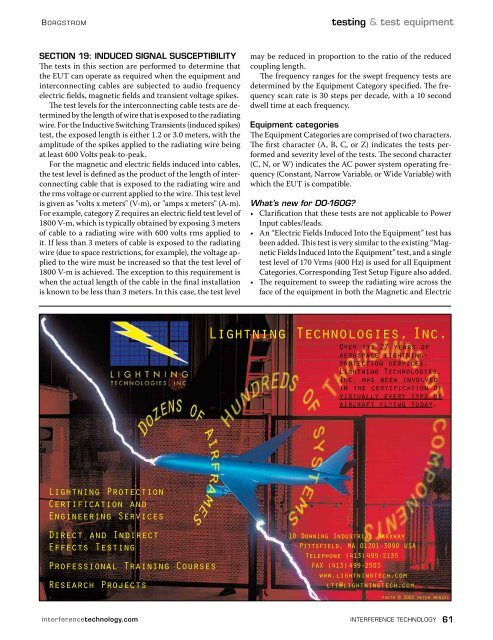

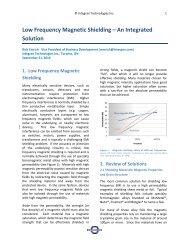

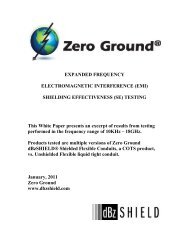
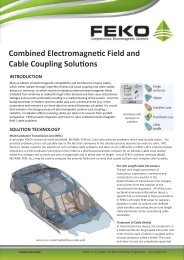

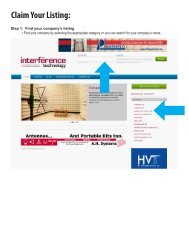

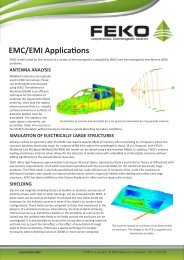
![[ thursday ] morning sessions 8:30 am-noon - Interference Technology](https://img.yumpu.com/23176841/1/190x247/-thursday-morning-sessions-830-am-noon-interference-technology.jpg?quality=85)
